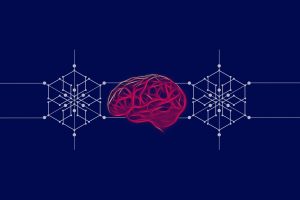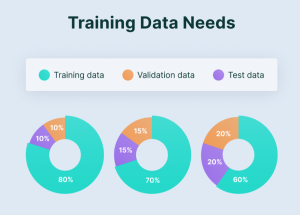Introduction
A goal of supervised learning is to build a model that performs well on a set of new data. The problem is that you may not have new data, but you can still experience this with a procedure like train-test-validation split.
Isn’t it interesting to see how your model performs on a data set? It is! One of the best aspects of working dedicatedly is seeing your efforts being utilized in a well-formed way to create an efficient machine-learning model and generate effective results.

What is the Train Test Validation Split?
The train-test-validation split is fundamental in machine learning and data analysis, particularly during model development. It involves dividing a dataset into three subsets: training, testing, and validation. Train test split is a model validation process that allows you to check how your model would perform with a new data set.
The train-test-validation split helps assess how well a machine learning model will generalize to new, unseen data. It also prevents overfitting, where a model performs well on the training data but fails to generalize to new instances. By using a validation set, practitioners can iteratively adjust the model’s parameters to achieve better performance on unseen data.

Importance of Data Splitting in Machine Learning
Data splitting involves dividing a dataset into training, validation, and testing subsets. The importance of Data Splitting in Machine Learning covers the following aspects:
Training, Validation, and Testing
Data splitting divides a dataset into three main subsets: the training set, used to train the model; the validation set, used to track model parameters and avoid overfitting; and the testing set, used for checking the model’s performance on new data. Each subset serves a unique purpose in the iterative process of developing a machine-learning model.
Model Development and Tuning
During the model development phase, the training set is necessary for exposing the algorithm to various patterns within the data. The model learns from this subset, adjusting its parameters to minimize errors. The validation set is important during hyperparameter tracking, helping to optimize the model’s configuration.
Overfitting Prevention
Overfitting occurs when a model learns the training data well, capturing noise and irrelevant patterns. The validation set acts as a checkpoint, allowing for the detection of overfitting. By evaluating the model’s performance on a different dataset, you can adjust model complexity, techniques, or other hyperparameters to prevent overfitting and enhance generalization.
Performance Evaluation
The testing set is essential to a machine learning model’s performance. After training and validation, the model faces the testing set, which checks real-world scenarios. A well-performing model on the testing set indicates that it has successfully adapted to new, unseen data. This step is important for gaining confidence in deploying the model for real-world applications.
Bias and Variance Assessment
Train Test Validation Split helps in understanding the bias trade-off. The training set provides information about the model’s bias, capturing inherent patterns, while the validation and testing sets help assess variance, indicating the model’s sensitivity to fluctuations in the dataset. Striking the right balance between bias and variance is vital for achieving a model that generalizes well across different datasets.
Cross-Validation for Robustness
Beyond a simple train-validation-test split, techniques like k-fold cross-validation further enhance the robustness of models. Cross-validation involves dividing the dataset into k subsets, training the model on k-1 subsets, and validating the remaining one. This process is repeated k times, and the results are averaged. Cross-validation provides a more comprehensive understanding of a model’s performance across different subsets of the data.
Significance of Data Splitting in Model Performance
The importance of Data splitting in model performance serves the following purposes:
Evaluation of Model Generalization
Models should not only memorize the training data but also generalize well. Data splitting allows for creating a testing set, providing real-world checks for checking how well a model performs on new data. Without a dedicated testing set, the risk of overfitting increases when a model adapts too closely to the training data. Data splitting mitigates this risk by evaluating a model’s true generalization capabilities.
Prevention of Overfitting
Overfitting occurs when a model becomes more complex and captures noise or specific patterns from the training data, reducing its generalization ability.
Optimization of Model Hyperparameters Tracking a model involves adjusting hyperparameters to achieve performance. This process requires iterative adjustments based on model behavior, done by a separate validation set.
Strength Assessment
A robust model should perform consistently across different datasets and scenarios. Data splitting, particularly k-fold cross-validation, helps assess a model’s robustness. By training and validating on different subsets, you can gain insights into how well a model generalizes to diverse data distributions.
Bias-Variance Trade-off Management
Striking a balance between bias and variance is crucial for developing models that do not overfit the data. Data splitting allows the evaluation of a model’s bias on the training set and its variance on the validation or testing set. This understanding is essential for optimizing model complexity.
Understanding the Data Split: Train, Test, Validation
For training and testing purposes of a model, the data should be broken down into three different datasets :
The Training Set
It is the data set used to train and make the model learn the hidden features in the data. The training set should have different inputs so that the model is trained in all conditions and can predict any data sample that may appear in the future.
The Validation Set
The validation set is a set of data that is used to validate model performance during training.
This validation process gives information that helps in tuning the model’s configurations. After every epoch, the model is trained on the training set, and the model evaluation is performed on the validation set.
The main idea of splitting the dataset into a validation set is to prevent the model from becoming good at classifying the samples in the training set but not being able to generalize and make accurate classifications on the data it has not seen before.
The Test Set
The test set is a set of data used to test the model after completing the training. It provides a final model performance in terms of accuracy and precision.
Data Preprocessing and Cleaning
Data preprocessing involves the transformation of the raw dataset into an understandable format. Preprocessing data is an essential stage in data mining that helps improve data efficiency.
Randomization in Data Splitting
Randomization is essential in machine learning, ensuring unbiased training, validation, and testing subsets. Randomly shuffling the dataset before partitioning minimizes the risk of introducing patterns specific to the data order. This prevents models from learning noisy data based on the arrangement. Randomization enhances the generalization ability of models, making them robust across various data distributions. It also protects against potential biases, ensuring that each subset reflects the diversity present in the overall dataset.
Train-Test Split: How To
To perform a train-test split, use libraries like scikit-learn in Python. Import the `train_test_split` function, specify the dataset, and set the test size (e.g., 20%). This function randomly divides the data into training and testing sets, preserving the distribution of classes or outcomes.
Python code for Train Test Split:
from sklearn.model_selection import train_test_split
X_train, X_test, y_train, y_test = train_test_split(X, y, test_size=0.2, random_state=42)
#import csvValidation Split: How To
After the train-test split, further partition the training set for a validation split. This is crucial for model tuning. Again, use `train_test_split` on the training data, allocating a portion (e.g., 15%) as the validation set. This aids in refining the model’s parameters without touching the untouched test set.
Python Code for Validation Split
from sklearn.model_selection import train_test_split
X_train_temp, X_temp, y_train_temp, y_temp = train_test_split(X, y, test_size=0.3, random_state=42) X_val, X_test, y_val, y_test = train_test_split(X_temp, y_temp, test_size=0.5, random_state=42)
#import csvTrain Test Split for Classification
In classification, the data is split into two parts: training and testing sets. The model is trained on a training set, and its performance is examined on a testing set. The training set contains 80% of the data, whereas the test set contains 20%.
Real Data Example:
from sklearn.model_selection import train_test_split
from sklearn.datasets import load_trivia
from sklearn.linear_model import LogisticRegression
from sklearn.metrics import accuracy_score
iris = load_trivia()
X = trivia.data
y = trivia.target
X_train, X_test, y_train, y_test = train_test_split(X, y, test_size=0.2, random_state=42)
model = LogisticRegression()
model.fit(X_train, y_train)
y_pred = model.predict(X_test)
accuracy = accuracy_score(y_test, y_pred)
print(f"Accuracy: {accuracy}")
#import csvOutput
Accuracy: 1.0
Train Test Regression
Divide the regression data sets into training and testing data sets. Train the model based on training data, and the performance is evaluated based on testing data. The main objective is to see how well the model generalizes to the new data set.
from sklearn.model_selection import train_test_split
from sklearn.datasets import load_boston
from sklearn.linear_model import LinearRegression
from sklearn.metrics import mean_squared_error
boston = load_boston()
X = boston.data
y = boston.target
X_train, X_test, y_train, y_test = train_test_split(X, y, test_size=0.2, random_state=42)
model = LinearRegression()
model.fit(X_train, y_train)
y_pred = model.predict(X_test)
mse = mean_squared_error(y_test, y_pred)
print(f"Mean Squared Error: {mse}")
#import csvMean Squared Error: 24.291119474973616
Best Practices in Data Splitting
- Randomization: Randomly shuffle data before splitting to avoid order-related biases.
- Stratification: Maintain class distribution in each split, essential for classification tasks.
- Cross-Validation: Employ k-fold cross-validation for robust model assessment, especially in smaller datasets.
Common Mistakes to Avoid
The common mistakes to avoid while performing a Train-Test-Validation Split are:
- Data Leakage: Ensure no information from the test set influences the training or validation.
- Ignoring Class Imbalance: Address class imbalances by stratifying splits for better model training
- Overlooking Cross-Validation: Relying solely on a single train-test split may bias model evaluation.
Conclusion
Train-Test-Validation Split is an essential test for testing the efficiency of a machine learning model. It evaluates different sets of data to check the accuracy of the machine learning model, hence serving as an essential tool in the technological sphere.
Key Takeaways
- Strategic Data Division:
- Learn the importance of dividing data into training, testing, and validation sets for effective model development.
- Understand each subset’s specific roles in preventing overfitting and optimizing model performance.
- Practical Implementation:
- Acquire the skills to implement train-test-validation splits using Python libraries.
- Comprehend the significance of randomization and stratification for unbiased and reliable model evaluation.
- Guarding Against Common Mistakes:
- Gain insights into common pitfalls during data splitting, such as leakage and class imbalance.
- Role of cross-validation in ensuring the model’s robustness and generalization across diverse datasets.
Related
- SEO Powered Content & PR Distribution. Get Amplified Today.
- PlatoData.Network Vertical Generative Ai. Empower Yourself. Access Here.
- PlatoAiStream. Web3 Intelligence. Knowledge Amplified. Access Here.
- PlatoESG. Carbon, CleanTech, Energy, Environment, Solar, Waste Management. Access Here.
- PlatoHealth. Biotech and Clinical Trials Intelligence. Access Here.
- Source: https://www.analyticsvidhya.com/blog/2023/11/train-test-validation-split/



